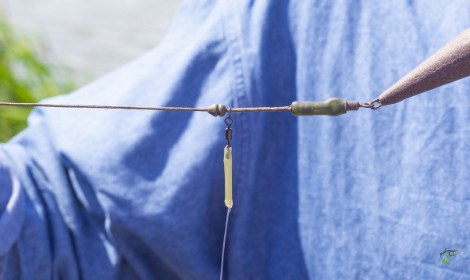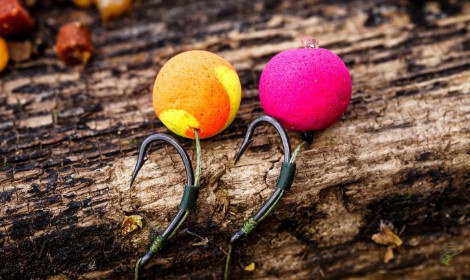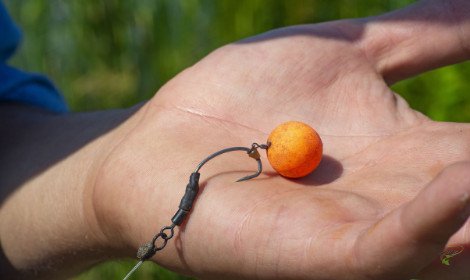
All anglers worth their salt knows that if you want to have a great day on the water, you need to find the place with the highest carp population. It makes fishing a lot more fun, and the fight that the carp provide is very entertaining. However, the huge problem is that carp usually gather in weedy spots with a lot of aquatic vegetation.
Fishing in these areas is a huge challenge as the line can easily get caught up in the weeds which results in lost fish. If you’ve been in carp fishing circles long enough, chances are you know what a chod rig is. But if not, this post is for you.
The chod rig is a fishing technique that anglers use to bypass these kinds of situations. The chod rigs help anglers fish over weedy waters or even waters with debris filled bottoms and tap into the aggregation of carp present there.
So, interested to know how the chod rig works? Let’s dive in!
What Is A Chod Rig?
Chod is the weed or debris (such as branches and decaying leaves) at the bottom of a lake or reservoir. Fishing in choddy waters is an absolute nightmare as the line catches into the weeds and does not present the bait perfectly to the fish.
A chod rig is a setup that allows anglers to fish over weedy or debris filled bottoms. The lead attached to the chod rig sinks to the bottom, allowing the hookbait to slide up with the help of its buoyant pop-up. This setup presents the hookbait perfectly to any fish cruising around the covers of aquatic vegetation.
There are several reasons why chod rigs are so popular right now. First, these rigs are an unbelievably useful weapon for when you need to fish in less than ideal conditions. The rig combines chod filament and a hook with a swivel and a rig ring to form a setup that works in any condition that you fish it in.
Usually, most anglers would avoid fishing their bait in a weed depth over 2 feet. However, carp can be scarce in clear waters, especially when the fishing season is in full swing as they prefer the security provided by weed coverage. So the only choice you have left is to use a chod rig for fishing over weedy waters and presenting your bait above the weeds.
When To Use A Chod Rig
So, if the chod rig is such a great setup, why don’t anglers use it all the time? Yes, it truly is hard to go wrong with chod rigs, but it is a little tricky to get them right if you’re not an experienced angler. So, which situations should you use a chod rig in? Let’s find out.
Firstly, the chod rig is a great technique for any water that you want to fish with a pop-up bait. That means that if you don’t know what is at the bottom of a particular lake or other body of water, you should use a chod rig. The chod rig is the setup of choice in these cases because no matter what the bottom is like, the chod rig will catch carp just fine.
Secondly, the main use of a chod rig is to use it in choddy waters. This situation is where the chod rig truly shines as it presents the hookbait over the weed in such a way that the carp cannot resist it. You get instant bites and a lot of fun out of a chod rig when fished over weed and other underwater debris. It very rarely tangles in anything and doesn’t sink the hookbait to the bottom as other rigs would.
It is also a great option for anglers who are looking for some economical options. A chod rig is a great option that utilizes the single-bait method and saves you the money you would otherwise spend on groundbait and PVA bags.
How to Set Up A Chod Rig

Tying a chod rig requires a certain degree of technique and precision. This precision comes with practice and a lot of patience. However, if you find it too complicated to tie it, you can purchase pre-tied rigs from your nearest tackle shop too.
So, what will you need to tie the chod rig? Let’s see.
- Good quality chod filament
- A chod hook of your choosing (If you use 16 mm popups, your hook should be a size 6.)
- Some tungsten putty for balance
- A chod swivel (Size 11 is a good option.)
- Some bait floss
- A Rig ring
- A pair of Scissors
- A small Lighter
Now that you’ve gathered all the things you will need to tie a chod rig, how will you attempt it? Let’s find out.
- Your first step is to cut off 8 inches of the chod filament. Then thread your hook into the filament.
- Tie a knotless knot around the hook shank. You can do this by wrapping the material around itself.
- Make sure to wrap it around itself up to seven times.
- Then, pass the free end of the filament through the eye of the hook shank and pull it down so that it is quite tight.
- Then, thread a rig ring into your chod filament.
- After that, pass the free end of the filament with the rig ring in it back through the eye of the hook.
- Then pull the filament down until it makes a D-shaped hole in between.
- Make sure the rig ring easily slides up and down the D-shaped filament.
- Cut the free end that is protruding out.
- Then, using a lighter, melt the filament until it reaches the hook. Once there, tap it with the lighter’s bottom to create a flat surface from the melted filament.
- After that, pick up the other end of your filament and tie a chod swivel to it.
- Wrap the line a couple of times around itself before passing it back through the hole that the filament created around the swivel.
- Moisten the knot with saliva to avoid friction. Then, pull it.
- Cut the tag end and melt it off too in the same way as described before.
- Now, cut off some bait floss and pass it through the rig ring.
- Attach the bait to the bait floss and then blob it.
- Afterwards, you can shape your chod rig into a curved shape for a better swim.
- Then, pick up a little bit of tungsten putty and warm it up by rubbing it in your fingers.
- Then, wrap the tungsten putty around the barrel of the chod swivel to balance its weight.
Was that a little hard to attempt? Fear not. All anglers learn by practising the different methods several times to see other anglers attempt on their fishing trips.
The best time to practice tying and fishing a chod rig is when the waters are free of anglers. So find a peaceful weedy spot and get to work!
Hook Baits For Chod Rigs

The best hookbaits for chod rigs are undoubtedly popped up boilies. Traditionally called pop-ups, these hookbaits present in a very attractive way so that the carp cannot resist them. You can find these pop-ups in a variety of different flavours and colours.
If you’re having trouble getting the fish to respond to one colour of hookbait, try a different one, and you might just get lucky!
The most important element of pop-ups is their buoyancy. This buoyancy allows the hookbait to float up when the lead has sunk to the bottom between the weeds. This suspended hookbait presents in such a way that the carp can bite into because it is essentially lying on top of the weeds.
So, what are the different types of hook baits for chod rigs? Let’s find out.
Corkball Pop-ups
These pop-ups are the most commonly used pop-ups for chod rigs. These pop-ups have the most buoyancy and float well over the level of detritus lining the bottom of the water.
This bait has a fine paste layered over a corkball.
Cork Dust Pop-ups
Cork-dust pop-ups are made out of real fragments of cork. This element gives them a lot of buoyancy which makes them an ideal option for chod rigs.
Airball Pop-ups
Airball pop-ups are made up of a buoyant paste that helps them stay afloat in weedy waters. However, these pop-ups are more typically used with hair rigs.
There are several other types of pop-ups as well. However, those are not used with chod rigs. The great thing about using pop-ups with chod rigs is its buoyancy and variety in colour and texture. Its bright colours help the bait stand out in dark weeds and silt. Manufacturers also layer some attractive pastes on these pop-ups to make them more attractive to carp.
Chod Rig Tips And Tricks

Even though the chod rig offers some pretty solid results on its own, it’s best to learn a few tips and tricks as well so you know what to do when the carp aren’t biting. Another reason why you should learn some chod rig tricks because it’ll help your rig stand out from other similar setups.
In that way, you’ll be able to attract a greater degree of fish to your bait. Want to learn some cool tricks to make your chod rig technique really shine? Let’s dive in!
- Before heading out, do check the buoyancy of your pop-ups. Soak them in a water container overnight and see how they behave. If they remain afloat, you should use them. This step is important because some boilies take up water and get heavier, falling to the bottom in the process.
- Test the falling rate of your pop-up. If it falls too fast, you can try inserting some leadcore bits into the pop-up to make it stay afloat longer.
- Make sure your hook size corresponds with the size of your boilie. For example, while a size six hook is perfect for a 16mm boilie, a 12mm will require you to use a size eight hook.
- Make sure your filament curves in the area of the hook point. You can do this by working it that way with your fingers or using a steaming cone to achieve the same effect.
- Make sure to balance the setup by applying some putty to the cylinder of the chod swivel. This step will ensure that your chod rig is balanced when you cast it in the water.
- While most anglers use lead-core with chod rigs, you can also use fluorocarbon lines if you wish for a more seamless presentation that the carp don’t spot too easily.
- Always fish with a light hand. Make sure the line is slack so that it does not exert any unnecessary stress on the setup.
- Most experienced anglers will stress upon the size of the lead. A smaller lead will have a better presentation and will not sink as soon as a bigger lead.
- If you pre-bait the area before you show up with a chod rig, you can end up making a huge difference in the number of carp you catch.
- Test out your chod swivels by making sure they rotate easily. If they offer even the smallest amount of resistance, they’re not worth using in the water.
- Make sure your rig is placed around the top bead and not attached to a line clip, as it will limit the effectiveness of your hookbait.
- Make sure your lead-core weighs a good amount. If your lead core is too thin or if your line is lead-free, it will end up floating far above the weeds, which will defeat the entire purpose of a chod rig.
That’s a lot of handy tricks, isn’t it? But, if you think so, you should definitely try these out next time you’re on the water.
That’s All
If you like angling that provides a challenge, mastering the chod rig should be next on your to-do list. While it is a fairly complicated setup, it is extremely useful for when you don’t know what the bottom of a particular lake looks like or is particularly weedy or silty.
In these situations, anglers who haven’t yet learned to work the chod rig will fall short while you’ll be a smashing success on the water. So, ready to work that chod filament yet? Then, head to your nearest tackle shop and get to work.


